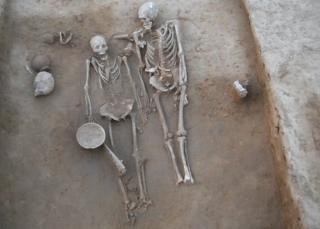- UID
- 20
- Online time
- Hours
- Posts
- Reg time
- 24-8-2017
- Last login
- 1-1-1970
|

Vasant Shinde
▼ About 4,500 years ago, a man and a woman were buried in a grave together in a sprawling cemetery on the outskirts of a thriving settlement of one of the world's earliest urban civilisations.
In 2016, archaeologists and scientists from India and South Korea found these two "very rare" skeletons in a Harappan (or Indus Valley) city - what is now Rakhigarhi village in the northern Indian state of Haryana. For two years, they researched the "chronology" and possible reasons behind the deaths; and the findings have now been published in a peer-reviewed international journal.
"The man and the woman were facing each other in a very intimate way. We believe they were a couple. And they seemed to have died at the same time. How they died, however, remains a mystery," archaeologist Vasant Shinde, who led the team, told me.
They were buried in a half-a-metre-deep sand pit. The man was around 35 years old at the time of his death, while the woman was around 25. Both were reasonably tall - he was 5.8ft (1.77m) and she, 5.6ft. They were both possibly "quite healthy" when they died - tests didn't find any lesions or lines on the bones or any "abnormal thickness" of skull bones, which could hint at injuries or diseases such as brain fever.
Archaeologists say this unique "joint grave" was not an "outcome of any specific funeral customs commonly performed at that time". They believe that the man and the woman "died almost at the same time and that, therefore, they had been buried together in the same grave".
Ancient joint burial sites have always evoked interest. (▪ ▪ ▪)
► Please, read the full news here: Source |
|